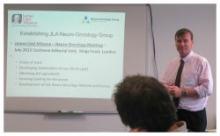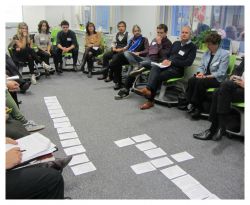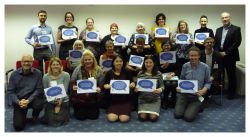

The Cochrane Gynaecological, Neuro-oncology and Orphan Cancers Group (CGNOC) has previously undertaken several prioritization exercises. In 2007, the Cochrane Gynaecological Cancer Group (as it was known then) worked with NHS Gynaecological Cancer Network, a range of professional bodies including the British Gynaecological Cancer Society (BGCS) and the National Forum of Gynaecological Oncology Nurses, the National Cancer Research Institute (NCRI) and the charities Ovacome and Jo’s Cervical Cancer Trust, as part of the UK NIHR Cochrane Programme Grant Scheme. Stakeholder representatives from all of these groups attended a meeting in September 2007 at which the top 20 gynaecological cancer review titles were selected by consensus. The group has repeated this process twice since then. Past prioritization activities of the neuro-oncology team involved content editors, representatives from charities, the European Association of Neuro-Oncology, and the Society for Neuro-Oncology. The prioritized topics were promoted at the World Federation of Neuro-Oncology Societies meeting.
The most recent CGNOC prioritization activities have been through James Lind Alliance Priority Setting Partnerships (JLA PSP) on brain and spinal cord tumour and womb cancer. Both exercises followed the standard JLA priority setting partnership process: gathering uncertainties, data analysis and verifying uncertainties, interim priority setting, and final priority setting.
Brain and spinal cord tumours
 The brain and spinal cord tumour JLA PSP was carried out between 2013 and 2015 in collaboration with patients, carers, the British Neruro-Oncology Society (BNOS), representatives from each of the treating areas, and major brain and spinal cord tumour charities (Brain Tumour Charity, Brain Tumour Research, brainstrust, Children with Cancer, and the International Brain Tumour Alliance). The aim was to identify the most important clinical research questions on brain and spinal cord tumours that the group suspected were not being addressed because of the bias towards lab-based research in this area.
The brain and spinal cord tumour JLA PSP was carried out between 2013 and 2015 in collaboration with patients, carers, the British Neruro-Oncology Society (BNOS), representatives from each of the treating areas, and major brain and spinal cord tumour charities (Brain Tumour Charity, Brain Tumour Research, brainstrust, Children with Cancer, and the International Brain Tumour Alliance). The aim was to identify the most important clinical research questions on brain and spinal cord tumours that the group suspected were not being addressed because of the bias towards lab-based research in this area.
The NOCTURN website was created to seek unanswered clinical questions via a survey. Relevant charities and governmental, health, and research organizations were asked to alert their members to the survey, which was also publicized via press and social media. The survey was open-ended and participants could submit their questions via the website or in paper form. In total, over 600 individual questions were collected. Through a process of duplication, the removal of out-of-scope questions and a further consultation round, a list of 25 questions was prioritized at a workshop in November 2014. JLA facilitators used a modified Delphi and nominal group technique to help stakeholders reach a consensus on the final top 10.
In the run-up to the ‘launch’ of the questions at the annual British Neuro-Oncology Society meeting in July 2015, the team met with potential funding groups and charities. Representatives from the National Institute for Health and Care Excellence (NICE), NIHR, Cancer Research UK, NCRI Clinical Study Groups, BNOS, JLA, CGNOC, and patients discussed how to develop the top 10 questions to give them the best chance of being funded.
Through the NCRI the team is carrying out ‘incubator days’ on the JLA top 10 brain and spinal cord tumour priorities. A multidisciplinary group has completed five of these interactive workshops aimed at producing the best research trials proposals. Three systematic review titles based on the Top 10 questions have been prioritized by CGNOC. The work has been presented through platform and poster presentations in neuro-oncology meetings in America and Europe. To engage with the neuro-oncology community in Europe, America, and Asia, the group plans to promote the priority questions at the next World Federation of Neuro-Oncology Societies meeting.
Womb cancer
 The JLA PSP in womb cancer was carried out between 2014 and 2016, in collaboration with patients, carers, healthcare professionals, and representatives from the Womb Cancer Alliance, the BGCS, and CGNOC. Their aim was to highlight the need of research in endometrial (womb) cancer, the most common gynaecological cancer in developed nations, which has so far has been the subject of comparatively little research.
The JLA PSP in womb cancer was carried out between 2014 and 2016, in collaboration with patients, carers, healthcare professionals, and representatives from the Womb Cancer Alliance, the BGCS, and CGNOC. Their aim was to highlight the need of research in endometrial (womb) cancer, the most common gynaecological cancer in developed nations, which has so far has been the subject of comparatively little research.
The group followed the JLA priority setting method as described above to establish the top ten unanswered research question. A survey was promoted on the Womb Cancer Alliance website and flyers and advertisements were distributed through the mailing lists of the stakeholder groups, social media. National and local press releases were used to invite carers, patients, and clinicians to participate.
Out of the 786 individual submissions, 202 unique unanswered questions were identified. After a second survey, that number was reduced to 30. In a final face-to-face consensus meeting, attendees ranked the questions through guided discussions using modified nominal group methodology facilitated by independent JLA advisors. The final top ten most important clinical uncertainties in womb cancer were agreed by the full group. A video describing the project has been released and disseminated through the Womb Cancer Alliance and CGNOC websites and Twitter feeds. An article describing the process has been published in the Gynaecologic Oncology journal, and the work was presented at a recent BGCS meeting.
Benefits and challenges
 Both CGNOC teams – neuro-oncology and gynae-oncology – encountered similar challenges. They’d hoped to promote their surveys via posters placed in treatment centres in the UK, but unfortunately, due to a lengthy approval process, this wasn’t possible. They also reported that representation of elderly patients (>65) was low in both PSPs. Nevertheless, editorial base staff had a good experience overall of the JLA PSP model, despite the fact that it is not a particularly cheap prioritization option. They found the process informative, and the methodology systematic and transparent. Patient engagement is at the heart of the James Lind Alliance so in both cases an equal balance of patients and clinician input was achieved.
Both CGNOC teams – neuro-oncology and gynae-oncology – encountered similar challenges. They’d hoped to promote their surveys via posters placed in treatment centres in the UK, but unfortunately, due to a lengthy approval process, this wasn’t possible. They also reported that representation of elderly patients (>65) was low in both PSPs. Nevertheless, editorial base staff had a good experience overall of the JLA PSP model, despite the fact that it is not a particularly cheap prioritization option. They found the process informative, and the methodology systematic and transparent. Patient engagement is at the heart of the James Lind Alliance so in both cases an equal balance of patients and clinician input was achieved.
A recent NIHR program grant proposal based on a joint list of neuro/gynae-oncology reviews derived from the two JLA PSPs was not entirely successful. The group was disappointed that NIHR did not support a split proposal and that only brain and spinal cord tumour reviews will be funded despite womb cancer being very common and underfunded. However, the group has recently been awarded funding through the Cochrane Review Support Programme to take forward one of the priority womb cancer titles.
For any questions or comments about this blog series or if you’d like to tell us about your group’s prioritization work please contact Ruth Foxlee at the Cochrane Editorial Unit – rfoxlee@cochrane.org
Ruth Foxlee, Information Specialist, Cochrane Editorial Unit
Maria Gerardi, Administrative Assistant, Cochrane Editorial Unit

